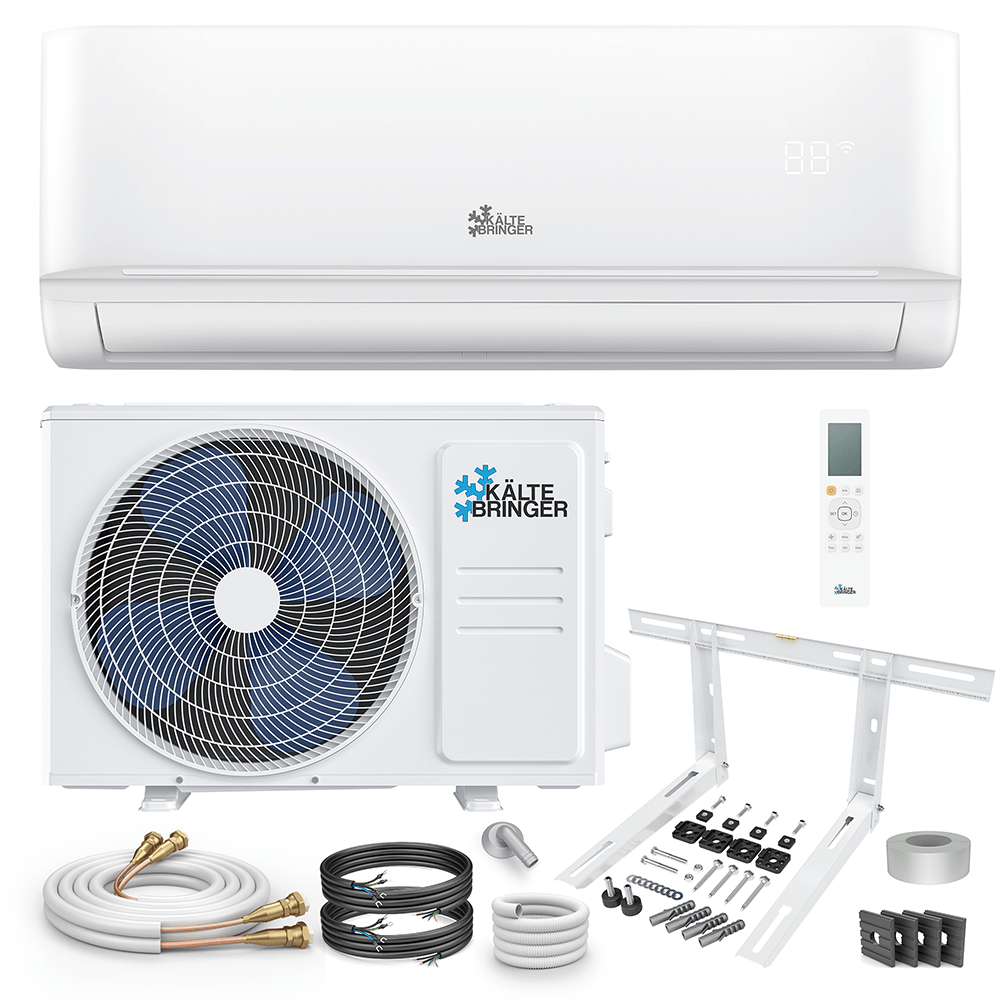Many people think of only one thing when they hear the word air conditioning – cooling in the summer. With a modern system, it is by no means the case that it has to gather dust in winter, because the devices can also be used to heat an apartment these days. Like modern air conditioning systems, they work today with a so-called "heat pump" to absorb the ambient heat. We briefly explained how the air conditioning can be used as heating in winter.
What actually is a heat pump?
A heat pump is a device that extracts heat from the environment and feeds it into a heating circuit. The first heat pump was used in a detached house as early as the 1960s. The world's first private heat pump used the temperature in the ground to operate low-temperature underfloor heating.
There are different types of heat pumps on the market. Depending on the design, the systems draw their heat from the ground, the air or the water. The heat gained is then gasified by a refrigerant and then compressed to obtain a higher temperature. The heat can then be fed into the heating circuit, i.e. it can contribute to heating the heating water.
Large heat pump systems, such as those used to extract heat from the ground, usually transfer it to the heating water in the pipes. However, there are also small heat pumps that can easily be retrofitted in any room.
The cold bringer air conditioners with heat pump transfer the temperature obtained directly to the air in the room with the help of a fan. The advantage of this so-called air-to-air heat pump is above all the low purchase price and the simple operation. How exactly it can be used, we look at in the next sections.
For which seasons is the air conditioning suitable as heating?
Heating with a heat pump is a good alternative to the rising prices of various raw materials. It works independently and only electricity is required for operation, which can possibly even be obtained from your own photovoltaic system.
As soon as autumn begins, many people in Germany turn their heating up to full blast. This is mainly because many people think the temperature is colder than it actually is due to the long summer. As a result, even at cool temperatures, heating costs are far too high.
Experts see the potential of the heat pump precisely in this transitional period. Since heating with oil or gas is very expensive, especially in the first cold days, the heat pump offers a high potential for savings. The air-to-air heat pump makes the most sense in the months of September, October and November. As a guideline, the outside temperature should not fall below five degrees, otherwise there will not be enough heat in it.
In order to guarantee effective heat distribution, the location of the air conditioner/heat pump must be well chosen from the start. The device should be placed as centrally as possible on an outer wall of the building. Of course, the cooling and heating capacity also has its limits, which is why the air conditioning system should always be selected according to the size of the room.
In winter, air conditioning systems unfortunately reach their limits as heating because there is not enough heat in the outside air. The indoor devices then consume far too much electricity and are more like a hot air dryer than a pleasant heater. In addition, the device would have to constantly activate the fan at a high level in order to keep the whole room at the correct temperature.
For the cold phases of winter, we recommend purchasing an infrared heater, such as one of the models from Bringer, developed in Germany. Infrared panels are considered to be one of the most future-proof heating systems, as they are not dependent on any raw materials and also only heat objects and people in a room. They don't “give away” heat to the air.
What should be considered when changing over in winter?
Split air conditioners are usually installed by a specialist company and placed in such a way that they cool as effectively as possible. In order to also guarantee efficient heating, this should be discussed with the specialist company beforehand. The outdoor unit is then placed in such a way that the air intake area is as large as possible.
When placing the outdoor unit, there are a few small things that should be considered:
Neighbors - outdoor units of a cold bringer air conditioner/heat pump work very quietly. Regardless of the power level, the systems do not emit any noise above a volume of 55 decibels, which is roughly comparable to soft radio music or the chirping of birds. However, the systems are not completely quiet, so the location should be chosen so that no neighbors feel disturbed. If in doubt – just talk to each other!
Building Regulations - In most municipalities, counties and states, air conditioning systems with integrated heat pumps do not require a permit and can easily be installed in the home. However, individual areas in Germany require approval because the systems could change the image of the neighborhood. To be on the safe side, you should always check with the responsible building authority before installation. No air conditioning may be installed on listed buildings.
Rental Apartments & Houses - If you are renting, installing a split air conditioner is not as easy as this is not a homeownership. The (preferably written) permission of the landlord must always be obtained so that the structural changes can be made. A split air conditioner requires a hole in the wall to connect the outdoor and indoor units.
Placement of the outdoor unit - When choosing the location of the outdoor unit, you should always bear in mind that several indoor units can be operated with one outdoor system. Even if you only decide on one indoor unit for the time being, the outdoor unit should be as centrally located as possible.
If all of these points have been observed, nothing stands in the way of using a heat pump in winter. The changeover works automatically with all Kältebringer devices, as the thermostat notices when heating is required to maintain the desired temperature. However, you should keep an eye on the outside temperature in order to switch on your alternative when the temperature is too low.
Conclusion
Air conditioners can do much more than just cool. Modern devices help with the room temperature both in summer and in winter and can be real helpers when it comes to saving. Since they only depend on electricity and use existing heat, they are also considered to be one of the most sustainable heating systems.
Are you interested in an air conditioning system with a heat pump or would you like to know your individual heating requirements? You can find all the information and many other blogs about heat pumps and air conditioning systems on the Kältebringer website. Convince yourself and browse through our diverse range.









